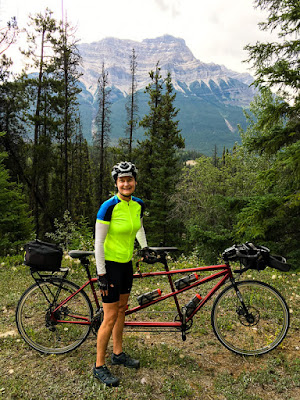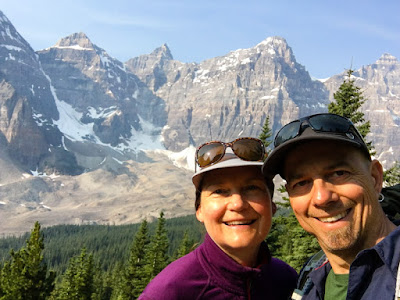
We headed to Banff National Park. We visited the visitor center and learned it’s the oldest national park in Canada, established in 1885. We liked the park’s new logo.

We set up camp in the Lake Louise campground. We had forgotten to charge our air mattress pump, but luckily Pete figured out how to use our bike pump to inflate our air mattress.

From Lake Louise we started hiking up towards Lake Agnes. The park has good signage about staying on the paths to keep from trampling the wildflowers.

The next day we drove to Moraine Lake. This is a wildlife crossing bridge that enables wolves, coyotes, deer and bears to safely cross the highway.

There are also wildlife crossing underpasses and all are equipped with motion activated cameras. We liked seeing such a big number of safe crossings!

On our third and final day in Banff we drove north to Bow Lake. The hike to Bow Glacier Falls started along the lake. We loved seeing the spectacularly blue-green water caused by rock silt.

After hiking back we drove to Jasper National Park. The town of Jasper is inside the national park. This is the Two Brothers Totem that was installed in Jasper in 2011, to celebrate Parks Canada’s centennial.

The bottom of the totem has a dragonfly. The finished totem pole is almost 14 meters tall and is painted in traditional First Nation Haida colors of red, black and blue.

The next day we went for a bike ride. As Kristina posed for this photo with our tandem we heard the sound of thunder in the distance. We hopped back on the bike and pedaled as fast as we could, but we had to ride almost an hour in the rain.

The rain let up but the sky remained cloudy for a few days. We camped near the Athabasca River, and enjoyed walking along it.


The Athabasca is fed by glacial melt, so it has the characteristic milky-blue color. Here you can also see the currents in the river.

We even went to ranger-led ‘campfire’ program that was fun, although there was no campfire due to a fire ban. Here the girl on the left is practicing putting out forest fires (by spraying the other kids holding fire photos).

The next day we hiked Opal Hills in Jasper. The trail was partly closed because of a female grizzly bear and her cub.

We could also see quite a few dead trees, evidence of the mountain pine beetle outbreak exploding in the past four years.

We hiked the fascinating Maligne Canyon, unknowingly starting backwards where the Maligne River is at its largest.

Maligne Canyon is actually a gorge and at points it’s 50 meters deep. It was impressive to see how fast the water roared.

The walls of the gorge are made of limestone. We were not surprised to learn that the Canadian Rocky Mountain Parks are a UNESCO World Heritage Site.

The next day we drove out to Miette Hot Springs. On the way we saw an elk grazing by the side of the rode.

We also were in a mountain goat traffic jam, as this herd of about 15 goats paused to lick salt from the road as they crossed.

Water flows from the mountain at 54°C but is cooled to 40°C for their outdoor pools. We decided to soak before we took a hike.

The next day we hiked on Mount Edith Cavell. The glaciers have mostly retreated, leaving behind a rocky landscape.

The marmots went about their business of foraging and didn't seem bothered by the hikers. It was fun to watch them.

In this photo the Angel Glacier’s distinctive green color comes out, as it does in the Edith Cavell Lake.

We left Jasper and drove to Glacier Waterton National Park. We had visited Glacier in 2014 and blogged about the park's history and geology. When we arrived we saw the iconic Jammers.
The impact of the glaciers on the landscape was clear.



There are less than 30 glaciers left in Glacier. Snow along the road seemed to be a magnet for other visitors.

The warning sign, “Danger, unstable snow, keep away” didn’t seem to deter people from getting really close.

In 2003 13% of Glacier burned in forest fires started by lightning. We hiked the Rocky Point Nature Trail and learned how important fire is for regenerating the forest.

To the left of the lake you can see what remains of the ‘fire mosaic’, the burn pattern that includes areas untouched by fire to sections that were completely burned.

























































